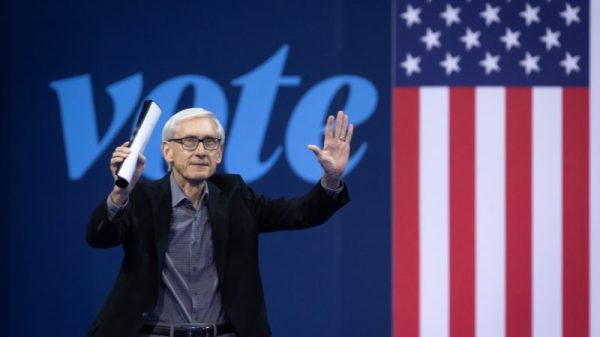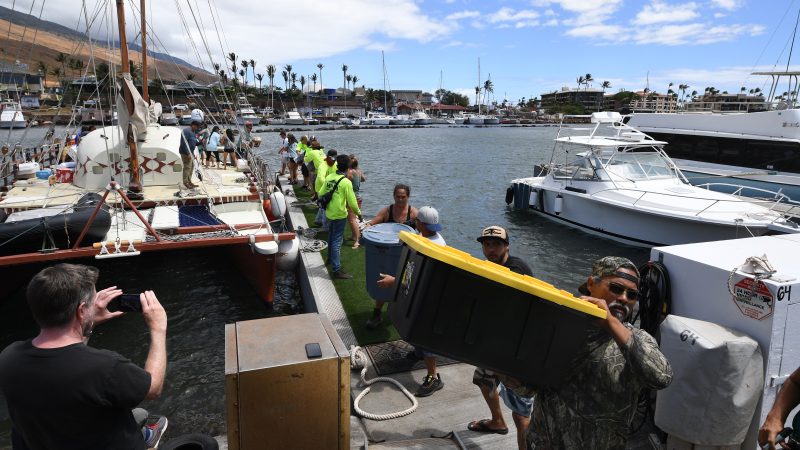Nine days after the deadliest wildfires in modern U.S. history scorched much of the historic town of Lahaina on Maui, many locals say they’re furious at a government response they describe as slow, inadequate and uncoordinated.
Some are struggling to find housing and daily necessities. Others say they lack medical aid, generators and transportation to recovery centers to hear news of their missing loved ones. It’s often not clear who is charge among local officials, the National Guard, Coast Guard and Federal Emergency Management Agency, some say.
Podcast episode
“We hear that we have lots of provisions, whether it be through FEMA or Red Cross, but everybody is on a different page,” said Dominick Gambino, who lives in the Maui community of Kula, where fires are also burning, and is part of a coalition organizing cleanup and aid distribution. “Emergency services and organizations that should be coordinated and organized, in the public eyes, have completely fallen through.”
Government officials, however, say the overall response has been fast and robust. FEMA, responsible for leading the federal response after natural disasters, says its rapid-response staff has been on the ground on Maui since last weekend. The response has ramped up this week, and the agency has now deployed close to 400 employees and 200 others for urban search and rescue teams alongside hundreds of troops to distribute emergency cash assistance, set up shelters, provide temporary housing in hotels and motels, and augment local search and recovery missions. FEMA’s warehouse on Oahu has supplied millions of meals and liters of water, blankets, cots, emergency generators and other supplies, officials said. As of Thursday the agency had distributed $3.8 million in emergency cash to about 1,600 local residents, officials said.
Hawaii Gov. Josh Green (D) said his office has been meeting daily to coordinate local rescue and recovery and firefighting efforts.
The disconnect points to the vast challenges that federal, state and local agencies face in helping everyone in need after an abrupt catastrophe on an island 2,900 miles off the California coast.
Maui wildfire updates
End of carousel
Those demands are coming as FEMA already is stretched thin by staff shortages amid costly and overlapping disasters fueled by climate change and financial shortfalls as its disaster relief fund nears a deficit by September. With full appropriations threatened by political fights in Congress over funding for the Ukraine war, FEMA officials warned in an email Wednesday that they may have to pause spending on “non-lifesaving and life-sustaining activities” without a quick infusion of money.
“A lot is falling on FEMA right now,” said Alice Hill, who oversaw planning for climate risks for the Obama White House and is now a senior fellow at the Council on Foreign Relations. “The agency is being asked to do the superhuman, but it doesn’t have the resources to do that.”
FEMA spokesman Jeremy Edwards said in an email that the agency “is working closely with the Administration to ensure adequate resources to meet all obligations to states, tribes, territories and households impacted by disasters.”
President Biden, who plans to travel to Maui with first lady Jill Biden on Monday to view damage from the fires and meet with first responders, survivors and government officials, praised the federal response this week, calling FEMA Administrator Deanne Criswell “the best we’ve ever had.”
“We’re going to coordinate relentlessly for the people on the ground to make sure the work continues,” the president said.
But Elle Cochran, a Democratic lawmaker who was born and raised in Lahaina and now represents her hometown in the Hawaii state House, says she’s been shut out of local and federal planning meetings.
“I am the state House representative, I should be a part of those plans, I should be part of that discussion,” Cochran said. “I have not been. From Day 1, I have been left in the dark. I feel like I’ve been iced out.”
The fire that devastated Lahaina, a town of 13,000, spread rapidly last week after powerful winds from a hurricane off the coast whipped through dry grasslands. As of early Thursday, 111 people had been confirmed dead, while search and rescue crews had searched about 40 percent of the burned areas. An unknown number of people are still unaccounted for.
FEMA officials said they began activating staff from multiple federal agencies on Aug. 9, as fires were still burning in Lahaina, positioning supplies at the agency’s distribution center on Oahu, conducting satellite imagery to assess the destruction and delivering aid to Lahaina shortly after that.
Criswell arrived on Maui early on Saturday, about 72 hours after the fires ripped across Lahaina. A former local firefighter in Colorado who has led FEMA since 2021, she confronted a significant logistical challenge in mobilizing the federal response.
By then local agencies were still at work battling fires and leading rescue missions; Maui County officials coordinated with the Red Cross to set up emergency shelters with food, water and medical supplies. And Green had authorized a review of the emergency response to the fires, which has come under criticism because of a lack of audible sirens and other warnings.
Any disaster response in Hawaii is complicated by the islands’ remoteness compared to mainland crises. And last week’s wildfires were what emergency management experts call a “no-notice event” — a sudden, fast-moving disaster that, unlike hurricanes, does not appear in weather forecasts. A nonstop flight from Los Angeles to Hawaii takes about five hours, and Maui is reachable only by plane or boat, drawing out the time for supplies and equipment to arrive. Lahaina, on the island’s western edge, is accessible only by water or a highway that for more than a week was heavily restricted. As the community waited for government help to arrive, it relied on its own distribution networks for supplies, lodging, medical checks and other support.
But Cochran said that each level of government — county, state and federal — shares the blame for what she characterized as a bungled disaster response. Cochran, who fled the fire as it bore down on the town last week, said some local and state leaders have been unwilling to accept help from outside groups such as the Cajun Navy, a volunteer, grass-roots relief group.
“Everything is run with ego and testosterone, that’s the name of the game,” Cochran said. “We are suffering because of it. … We need outside forces to help us.”
She said she had seen trucks full of generators and other supplies turned away from the checkpoints set up around town. Suppliers have been forced to find other drop-off points, outside the burn zone. Even as a state lawmaker, she had trouble getting back into her district after she evacuated.
On Wednesday, FEMA officials announced additional resources for the island, including the opening of a joint disaster-recovery center where survivors can meet face-to-face with agency staff and connect with volunteer groups and other federal and state resources.
In Washington, Gen. Mark A. Milley, chairman of the Joint Chiefs of Staff, told reporters that the Defense Department has 500 troops on the ground helping extinguish fires on Maui and removing heavy debris. The military also has provided cadaver dogs to help search through the ash and rubble, along with other logistical and infrastructure resources such as boats and aircraft for inter-island transport. More than 500 members of the Hawaii National Guard have also been activated to help with the recovery.
“We’ve provided fire support with helicopters and dropping buckets to help put out the fires,” Milley told The Washington Post in an interview. “Anything they need, they can get from us that we can provide … So right now we’ve got about 500 or so military physically participating on the island. And there’s more that could if the governor deems it necessary to do that, and we’re prepared to help out in any way we can.
That escalating federal response has largely been on target, given the extensive challenges, some involved in the efforts said.
“We are isolated, and getting things here is a logistical nightmare,” said Emily Johnston, a commercial charter boat captain on Maui who worked around-the-clock alongside the island’s maritime community until early this week to bring in supplies until FEMA arrived.
The test now, she said, is both for FEMA to deliver and for a community used to relying on itself to take advantage of federal assistance.
“We need the outside help, and I think everybody is acting with the best of intentions,” Johnston said, “but there’s a perception that FEMA needs to step up faster and start making things happen.”
FEMA officials said this week they have adequate resources to continue a full recovery effort in Hawaii amid Biden’s vow to give the islands everything they need for long-term recovery. But the response is highlighting the mounting challenges facing an agency that must constantly prepare for the next calamity.
In a decade that saw, on average, 62 major disaster declarations each year — with wildfires becoming a greater share than ever — the overlapping demands on FEMA are ballooning, and its resources cannot keep up, experts said. The federal government has not come up with a national strategy that plans for the accelerating pace of disasters, experts say, as the effects of climate change advance. Even now, a hurricane season is looming that officials expect to be worse than average.
“We’re starting to see growing disaster losses, and the consequence is that FEMA is on the hook to manage them and the federal taxpayer is left holding the bag,” said Daniel Kaniewski, who was deputy FEMA administrator during the Trump administration. He predicted that FEMA “will fall hopelessly short of what the Maui economy will need for the cost of rebuilding.”
FEMA has faced other new tests in recent years, from setting up mass vaccination sites and providing funeral assistance during the coronavirus pandemic to helping shelter an influx of migrants at the southern border. Burnout has led to an exodus of retirement-eligible staff, many with years of experience, leaving FEMA with a 35 percent staffing shortage across its disaster relief workforce in fiscal 2022, auditors found.
“You’ve got a burnout rate in the emergency management field in general, and that’s meant that at FEMA, people are cycling in and cycling out,” said Rep. Jared Moskowitz (D-Fla.), a former director of the Florida Division of Emergency Management.
Meanwhile, FEMA is running out of money to respond to disasters, both in the long and short term. Most of FEMA’s budget for direct disaster responses is supplied through supplemental appropriations from Congress — a sum that reached $469 billion from 1992 through 2021, according to the Congressional Budget Office.
FEMA has long relied on Congress to replenish its disaster relief fund near the end of the fiscal year, but the fund is on track to run out of money as soon as this month, Criswell told House lawmakers in July.
She said this week that as her staff anticipated what the deficit would be in September, “We took into account events just like this so we could support the initial response efforts.”
She added, “But we will need additional funding to ensure that all of our other recovery projects can continue and not get delayed until the next fiscal year.”
It remains unclear how much money Maui will need to fully rebuild. Crews on the ground are still going through the rubble in Lahaina, and it will take time for FEMA to come up with a recovery estimate that lawmakers could take to Congress. Initial estimates have run anywhere from $5 billion to $10 billion.
Moskowitz and Sen. Marco Rubio (R-Fla.) introduced legislation last week that would provide $11.5 billion in supplemental funding for the disaster relief fund — and the White House separately has asked Congress for $12 billion in emergency funding for FEMA.
Congress typically waits until near the end of hurricane season in November to appropriate billions for disaster relief across the country, which has already seen record flooding this summer. But the money will likely be tied to other supplemental requests from the Biden administration — including more than $24 billion the president is seeking to help Ukraine, a funding boost some prominent Republicans have vowed to fight.
While Senate Majority Leader Charles E. Schumer (D-N.Y.) has pledged to help Hawaii however he can, House Speaker Kevin McCarthy (R-Calif.) has dismissed the president’s supplemental budget request by reiterating to his colleagues this week that the White House never negotiated with Republicans on the numbers they requested. His warning serves as an early sign that Republicans could come out against large sums of aid funding as they prepare for combative fiscal fights.
FEMA’s needs could also get entangled in the imminent deadline to fund the government. House Republican leaders hope to pass a short-term extension to keep the government operating at 2023 fiscal levels, but it remains unclear if they have the votes to keep the government running past the end of the fiscal year on Sept. 30.
“I don’t remember the last time the whole fund needs supplemental funding in the heart of hurricane season,” Moskowitz said. “They shouldn’t have in the back of their minds that there’s an account that’s running out of money.”
Alex Horton and Leigh Ann Caldwell contributed to this report.





























